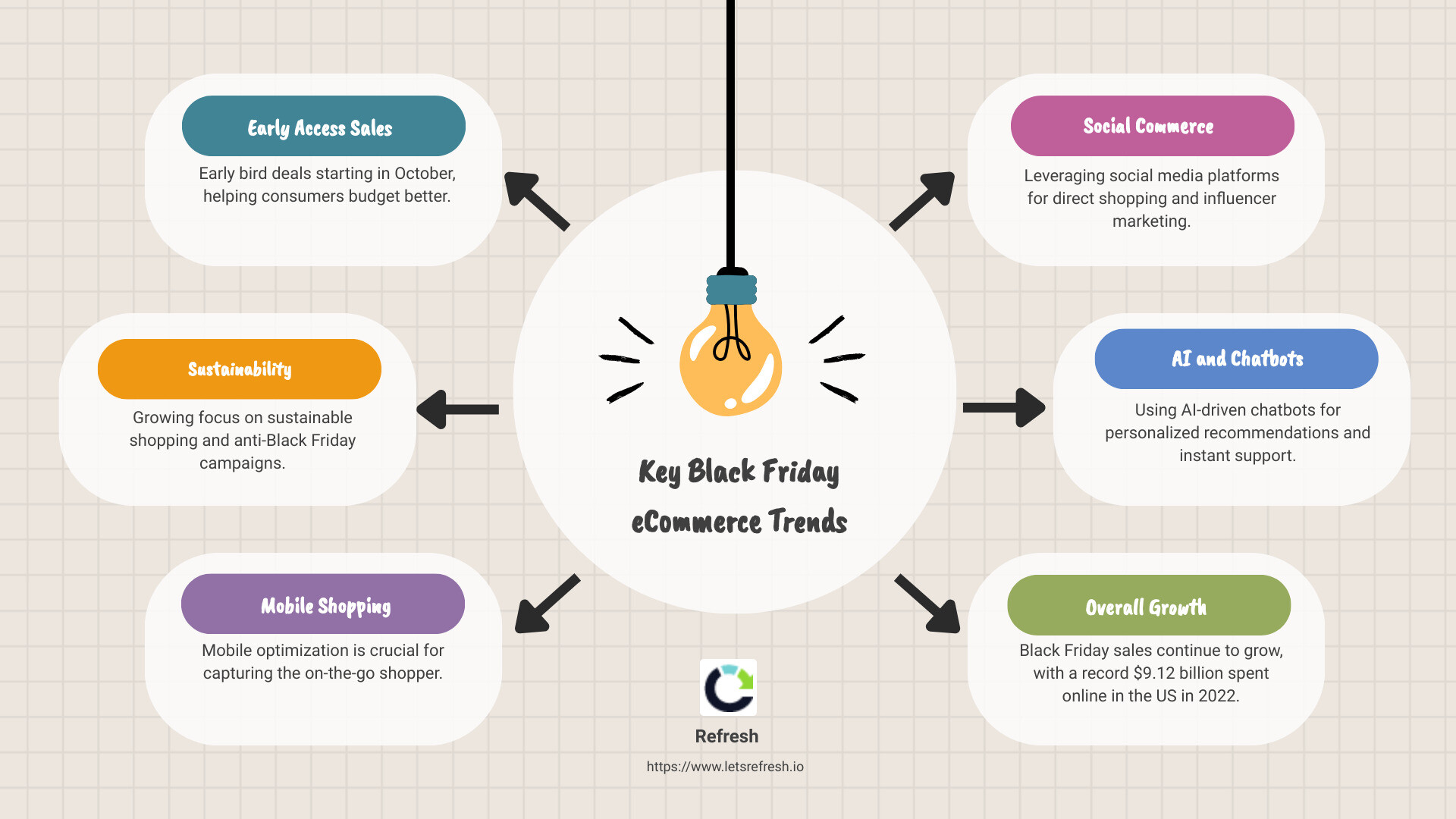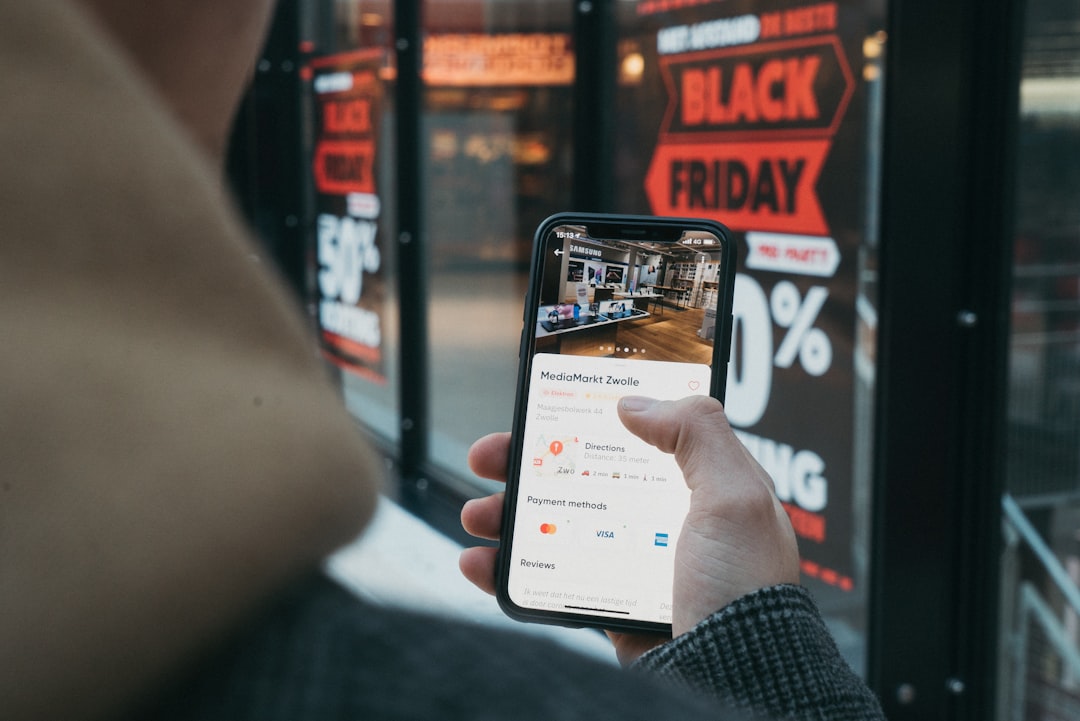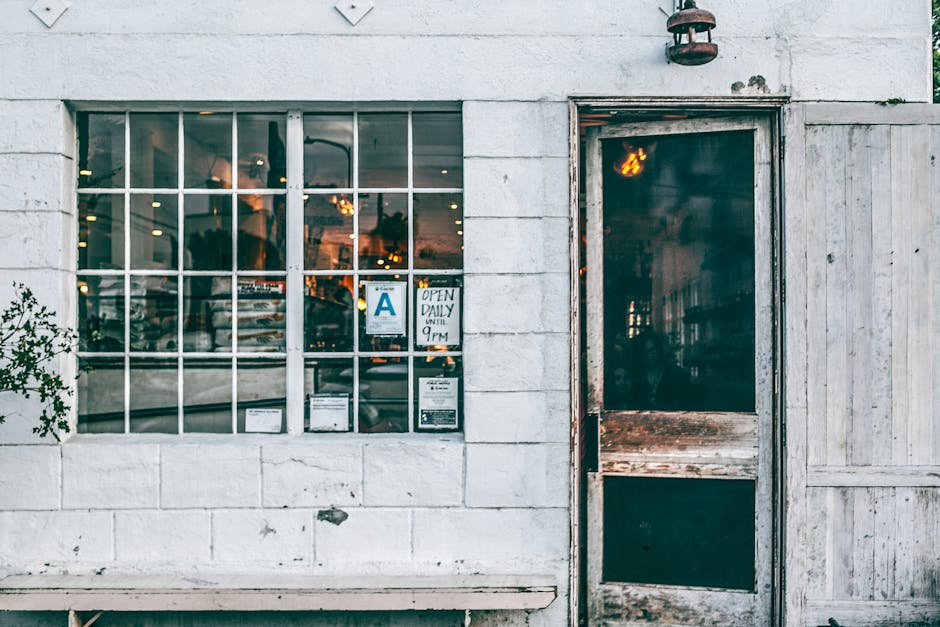July 24, 2025
Black Friday: eCommerce Growth and Consumer Spending
Black Friday eCommerce trends have revolutionized the way we shop during the holiday season. Here's a quick snapshot of the primary trends:
- Early access sales starting as early as October.
- A rising emphasis on sustainability and anti-Black Friday campaigns.
- The dominance of mobile and social commerce.
- Adoption of AI and chatbots for personalized shopping experiences.
Black Friday, traditionally an in-store shopping event, has significantly shifted towards online shopping. This shift is fueled by substantial eCommerce growth and increased consumer spending. In 2022, a record $9.12 billion was spent online in the US on Black Friday alone, according to Adobe Analytics. The convenience of online shopping combined with attractive deals makes Black Friday the kickoff for the holiday shopping frenzy.
With trends like early access sales and sustainable shopping influencing consumer behavior, retailers must adapt quickly to stay competitive. The days leading up to and including Cyber Monday now see immense online traffic, making it crucial for online retailers to prepare carefully.
As the Founder and CEO of Refresh Digital Strategy, I've helped numerous businesses steer the complexities of Black Friday eCommerce trends. My experience includes boosting client website traffic, developing effective digital strategies, and ensuring seamless online shopping experiences.
Let's explore Black Friday eCommerce trends and see how you can harness them for success.

Black Friday Sales Volume and Growth
Black Friday continues to dominate the holiday shopping season, showing impressive sales growth both online and in-store. According to Adobe Analytics, online sales on Black Friday reached a record $9.8 billion in 2023, marking a 7.5% increase from the previous year. This growth is driven by deep discounts, especially in categories like electronics, smartwatches, and televisions.

Online Sales Outshine In-Store Sales
Interestingly, online sales growth significantly outpaced in-store sales. The MasterCard SpendingPulse index reported an 8.5% increase in online sales on Black Friday, compared to a modest 2.5% rise in overall retail sales. This indicates a clear shift towards online shopping, with consumers preferring the convenience of eCommerce over the traditional in-store experience.
Impact of Price Deflation
One key factor contributing to this surge in online sales is the overall decline in prices. Adobe noted that retail site prices in October 2023 were 6% lower than the previous year. This price deflation created a favorable environment for consumers, making Black Friday deals even more attractive. Without this price drop, the growth in online sales might have been even higher.
Salesforce Insights
Salesforce also provided valuable insights, estimating a 9% increase in online sales in the U.S. and 8% globally on Black Friday. This growth was attributed to higher order volumes rather than inflation. Salesforce highlighted that discounts in the U.S. hovered around 30%, further driving consumer spending.
Key Growth Drivers
- Electronics: Adobe reported a 152% increase in electronics sales compared to a typical day in October.
- Footwear and Handbags: Salesforce noted a 22% growth in these categories.
- Sporting Goods: Sales in this category grew by 21%, according to Salesforce.
Fraud Prevention and Sales Trends
Signifyd, a provider of fraud-prevention services, observed an 11% year-over-year increase in sales for its clients on Black Friday. They also reported a decline in fraudulent orders by 19%, indicating improved security measures. Categories like apparel, cosmetics, groceries, and household goods saw a rise in sales, while luxury goods, home décor, and electronics experienced lower sales.
These trends highlight the evolving landscape of Black Friday shopping, with a clear preference for online deals and significant growth in specific product categories.
Next, let's dig into the Key Black Friday eCommerce Trends that are shaping the future of holiday shopping.
Key Black Friday eCommerce Trends
Early Access Sales
Early access sales are a big deal this Black Friday. Many consumers are starting their holiday shopping early to budget better, especially with rising living costs. According to Statista, early bird deals are more popular than ever.
In fact, in 2021, many shoppers began hunting for deals as early as October. Retailers should aim to launch their deals at the right time—not too early and not too late. This helps grab those early shoppers without missing out on the last-minute buyers.
Sustainability and Anti-Black Friday Campaigns
Sustainability is becoming a key factor for many consumers. Some brands are flipping Black Friday on its head with anti-Black Friday campaigns. For example, Patagonia focuses on sustainability, encouraging people to buy less and buy smarter.
Another great example is the British brand Finisterre. In 2021, they ran a "Blue Friday" campaign, donating proceeds to a foundation that helps people access the ocean. These campaigns emphasize helping others and being eco-friendly, showing that Black Friday doesn't have to be all about consumerism.
Mobile and Social Commerce
Mobile shopping is huge. According to Adobe, over 51% of all Black Friday spending will be done on mobile devices this year. Retailers need to optimize their sites for mobile to capture this market.
Social media also plays a big role. Last year, more than 50% of Polish retailers used social media for their Black Friday campaigns. Integrating social media shopping and influencer marketing can drive more traffic to mobile-optimized sites, boosting sales.
AI and Chatbots
Artificial Intelligence (AI) is making shopping easier and smarter. AI-driven chatbots can offer instant recommendations, helping shoppers find the best deals quickly. This not only improves the shopping experience but also increases conversion rates for retailers.
Personalized recommendations powered by AI can guide shoppers to products they are more likely to buy. This technology is becoming a must-have for online retailers aiming to maximize their Black Friday sales.
Next, let’s explore the Top Product Categories for Black Friday and see which items are flying off the virtual shelves.
Top Product Categories for Black Friday
Black Friday is a goldmine for certain product categories. Let's look at the top items that consumers are eager to snap up.
Electronics
Electronics are consistently among the most sought-after items during Black Friday. Shoppers are on the hunt for deals on gadgets and tech products. According to Adobe Analytics, the electronics category, including smartphones, TVs, and computers, sees significant discounts and high sales volumes. In 2022, electronics sales reached $21.7 billion during Cyber Week.
Smartphones are especially popular, as consumers look to upgrade to the latest models. TVs and computers also see substantial discounts, making them hot picks for Black Friday shoppers. Adobe predicts that electronics will continue to dominate Black Friday sales, with discounts expected to be around 30% for consumer electronics, 22% for TVs, and 24% for computers.
Clothing and Accessories
Fashion is another big winner during Black Friday. Clothing and accessories were the most popular items in 2022, with nearly 50% of all Black Friday purchases in the U.S. falling into this category, according to the National Retail Federation.
Shoppers are particularly interested in shoes, jewelry, and general apparel. Stores often offer significant discounts on these items, drawing in bargain hunters. In countries like Italy and Hungary, nearly 50% of consumers bought fashion items during Black Friday, highlighting the global appeal of fashion deals.
Beauty and Personal Care
The beauty sector also sees a surge in sales during Black Friday. Cosmetics, skincare, and other health and beauty products become hot commodities. In 2022, beauty items were among the top categories, with 23% of shoppers purchasing these products during Cyber Week.
Retailers often bundle products or offer "buy one, get one" deals, making it an attractive time for consumers to stock up on their favorite beauty items. The trend is expected to continue, with more people looking for deals on personal care products.
These categories—electronics, clothing and accessories, and beauty and personal care—are the heavy hitters during Black Friday. Retailers in these sectors should prepare for a busy period and ensure they have ample stock and attractive deals to lure in shoppers.
Next, we will dive into Black Friday eCommerce Statistics to understand the numbers behind these trends.
Black Friday eCommerce Statistics
Online Traffic and Mobile Usage
Black Friday eCommerce trends show a significant shift towards mobile shopping. In 2023, 79% of Cyber Week ecommerce traffic came from mobile phones, up from 76% in 2022, according to Salesforce. This increase highlights the growing importance of mobile optimization for online retailers.
Thanksgiving Day saw the highest mobile traffic, with 66% of sessions coming from mobile devices, as reported by Queue-it. Adobe's data supports this, noting that 59% of online sales on Thanksgiving were made via smartphones.
On Black Friday, 55.3% of sessions occurred on mobile devices, according to Cloudflare. However, Cyber Monday had a different trend, with only 50% of traffic from mobile, indicating a more balanced use of desktop and mobile devices on that day.
Conversion Rates and Average Spending
Conversion rates and average spending also provide insight into Black Friday eCommerce trends. On Black Friday, conversion rates were 6.5% on desktop and 3.2% on mobile. This suggests that while more people browse on mobile, they may prefer to complete purchases on desktop for a more detailed shopping experience.
In terms of average spending, the average items per order were higher on desktop (3.6 items) compared to smartphones and tablets (2.9 items each). This could indicate that desktop users are more likely to make larger purchases.
During Cyber Week, 38% of online sales came from mobile devices, a slight increase from last year, according to Big Commerce. Adobe's data shows an even higher figure, with 51.8% of online sales coming from mobile devices, up from 49.9% in 2022.
Overall, these statistics highlight the growing role of mobile in eCommerce, but also suggest that desktop still plays a crucial role in conversions and higher-value purchases.
Next, we will answer some Frequently Asked Questions about Black Friday eCommerce Trends to further explore these insights.
Frequently Asked Questions about Black Friday eCommerce Trends
Does Black Friday affect online shopping?
Absolutely! Black Friday has a significant impact on online shopping. According to Adobe Analytics, online sales reached a record $9.8 billion on Black Friday 2022, a 7.5% increase from the previous year. This growth is driven by deep discounts, especially in categories like electronics and smartwatches.
Consumer behavior also shifts during this period. Many shoppers prefer to avoid the crowds and shop from the comfort of their homes. Interestingly, Mastercard SpendingPulse reported that online sales grew 8.5% on Black Friday, while overall retail sales increased by only 2.5%.
What sells the most on Black Friday?
The top product categories during Black Friday are electronics, clothing, and beauty products.
- Electronics: Items like smartphones, TVs, and computers see massive discounts and high demand. Adobe Analytics noted a 152% increase in electronics sales compared to a typical day in October.
- Clothing and Accessories: Shoes, jewelry, and apparel are also popular. The National Retail Federation (NRF) found that fashion articles are among the most purchased items during Black Friday.
- Beauty and Personal Care: Cosmetics and skincare products see a significant boost in sales. Salesforce reported a 17% increase in health and beauty sales during Black Friday 2022.
Is it cheaper to shop online on Black Friday or Cyber Monday?
Both Black Friday and Cyber Monday offer substantial discounts, but the type of deals can vary.
- Black Friday: Known for deep discounts on electronics and bigger-ticket items. Adobe Analytics highlighted that electronics prices were particularly competitive during Black Friday.
- Cyber Monday: Often features flash sales and exclusive online deals. It’s the biggest online shopping day, with sales reaching $12 billion in 2022, according to Adobe.
For the best deals, consumers should compare prices across both days and consider the type of products they want to buy. Black Friday might be better for in-store and larger purchases, while Cyber Monday is ideal for snagging online-only deals and last-minute gifts.
Conclusion
As we've seen, Black Friday is an essential event for eCommerce, offering significant opportunities for increased sales, customer acquisition, and brand exposure. But thriving during this hectic period requires more than just good deals. It demands a robust digital strategy, seamless website performance, and effective marketing tactics.
At Refresh, we specialize in helping businesses steer the complexities of digital marketing. Our expertise in Webflow development ensures that your website is not only visually appealing but also optimized for performance and mobile-friendliness. This is crucial as mobile shopping continues to dominate Black Friday sales, with 51.2% of purchases predicted to come through mobile devices in 2023.
We also focus on SEO to improve your search engine rankings. This is vital for capturing traffic during the high-competition Black Friday period. Early planning and SEO efforts can help your pages rank higher when shoppers are actively searching for deals.
But our services go beyond just the technical aspects. We believe in building long-term partnerships with our clients. By understanding your unique business needs, we can tailor strategies that not only boost your Black Friday performance but also sustain growth throughout the year.
Ready to lift your Black Friday eCommerce strategy? Contact us today to learn how we can help you achieve your goals.
Still have questions? Let’s talk about it.
.avif)





